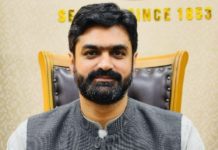ISLAMABAD, Sep 4 (DNA): Effectively reducing the prevalence of tobacco along with offering cessation services in healthcare centers, and robust advocacy efforts to counter innovative misinformation marketing tactics of novel smokeless tobacco products was the key to stemming the growing use of smoking products, said tobacco control experts at a webinar on Monday.
The webinar was organized by Sustainable Development Policy Institute and The Union for Tuberculosis and Ling Disease, a news release said.
Head, the Centre for Health, and Policy Innovation, SDPI, Syed Ali Wasif Naqvi remarked that although WHO Framework Convention on Tobacco Control mandates states to establish tobacco cessation services, only 30% of people out of the 780 million smoking quitters have access to such services.
Counseling and assistance can double the chances for a person to quit tobacco consumption and these must be provided by states to improve health indicators and reduce tobacco prevalence, he added.
Senior Technical Advisor, The Union for Tuberculosis and Lung Disease, Khurram Hashmi expressed that high prevalence of tobacco consumption exerts significant strain on healthcare systems and regional collaboration must be leveraged to achieve for sustainable impacts.
He urged that policy advocacy must be backed by rigorous evidence-based research and government’s tobacco control initiatives must be strengthened by resource allocations.
Advisor SDPI, Wasim Janjua remarked that in Pakistan, healthcare burden due to tobacco use stands at a
staggering Rs 615 billion, is a major challenge.
One critical gap hampering efforts to combat tobacco use is the absence of formal cessation services in both public and private hospitals.
Factors such as affordability and easy access, glamorization and normalization in society, media and culture, and lack of cessation services have collectively done a disservice to our awareness campaigns, making it more challenging to encourage smokers to quit tobacco, he said.
Director of Cancer Control Office at King Hussein Cancer Center (KHCC) Jordan, Dr. Nour Obeidat remarked that prevalence of tobacco consumption is high even among women in Middle East.
She stressed that political commitment was pivotal in making true progress in this regard to reduce tobacco prevalence and cessation.
She informed that since 2008, the number of clinics that offer vital brief and intensive cessation services had been increased to 25 by Jordan’s government.
Dental Public health Professional and Tobacco Cessation Specialist, India stressed that access to Nicotine Replacement Therapy (NRT), cessation support in healthcare centers, reimbursement services for cessation treatment and a national toll-free quit line for guidance to quit smoking can exponentially reinforce tobacco cessation efforts.
She highlighted that global governments have increased availability of tobacco cessation services.
She elucidated that 89% of high-income, 72% of middle-income and 18% of low-income countries offer only partial cost coverage. However, 32 countries provide no such assistance and Pakistan unfortunately is among them.
Dr Rakesh Gupta, President, SIPHER, India, acknowledged that tobacco companies are adapting to stringent tobacco control policies and declining sales. He pointed out that marketing tactics, like enticing fruit flavors and innovative packaging stimulate sales and combined with misleading claims of no nicotine, pose significant challenges to tobacco cessation efforts. This not only contributes to relapses among current users but also attracts new users, including children, raising significant public health concerns, he added. . He informed that responding to such tactics, over 18 Indian states have implemented bans on such e-cigarettes.
Dr. Sahana Hedge Shetiya, Professor & Head, Dept. of Public Health Dentistry Pune reiterated the need to focus advocacy and awareness efforts towards youth to prevent tobacco consumption initiation and draw on laws and regulations of the country to educate, fight misinformation using pictorial information.

















